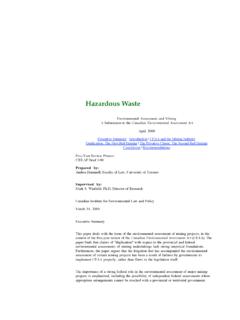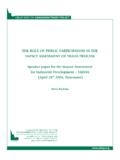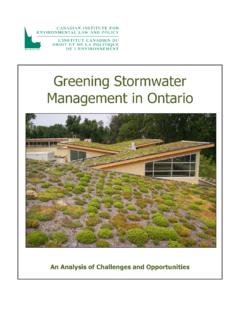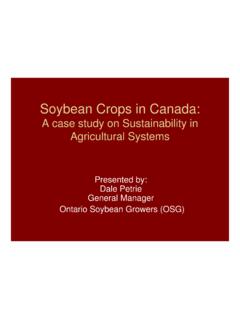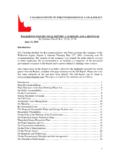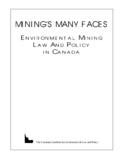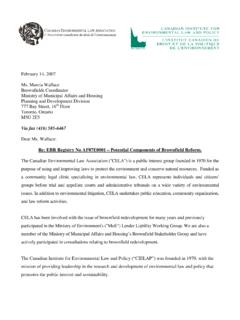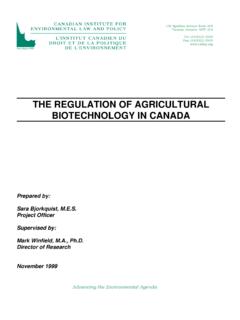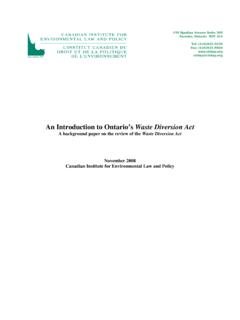Transcription of Drinking Water Quality Standards in Ontario - CIELAP.org
1 Drinking Water Quality Standards in Ontario Are They Tough? Satya P. Mohapatra and Anne Mitchell Canadian Institute for environmental Law and Policy 130 Spadina Avenue, Suite 305 Toronto, ON M5V 2L4 September 2003 ISBN # 1896 588 298130 Spadina Avenue Suite 305 Toronto, Ontario M5V 2L4 Tel: (416)923-3529 Fax: (416) the environmental Agenda 2 SUMMARY The Government of Ontario has started the process of legislating the Ontario Safe Drinking Water Act, as recommended in the second part of the Walkerton Report. Several regulations have been passed in the current year. However, the question still remains as to whether we have established safe Drinking Water Standards compared to other jurisdictions.
2 In this report, several chemical parameters with potential risk to human health including heavy metals and organic pollutants like insecticides, herbicides and other persistent organic chemicals are compared. There are a few examples like beryllium, molybdenum, nickel, endothall, endrin, hexachlorobenzene and toxaphene, for which, no standard is set by authorities either in Ontario or in Canada. Most of these chemicals have the potential to cause serious health problems. A matter of even more serious concern is the higher Maximum Acceptable Concentration (MAC) values of most of the pesticide residues and other persistent organic chemicals. These chemicals are highly persistent in the environment and are found in animal tissues at several locations in Canada.
3 Most of these chemicals are carcinogenic and possibly cause immunotoxicity and endocrine disruption affecting reproductive and nervous systems. The presence of these chemicals in Drinking Water is, therefore, completely unacceptable. The Ontario standard limits as well as the Canadian guideline values for most of the carcinogenic organic chemicals are higher than the USEPA standard and/or WHO guideline value. There are at least nine organic chemicals for which the MAC values in Ontario are at least one order of magnitude higher than the MAC suggested by WHO. We, therefore, wonder if the available scientific data on health risk associated with the ingestion of specific parameters are not properly evaluated or that we have a different definition of risk.
4 No new organic chemical having pronounced health effects has been considered for inclusion in the Ontario Drinking Water Standards by the Ontario Ministry of the Environment in the Safe Drinking Water Act. Further, none of the existing organic chemicals has been revised for tougher Standards . The Ontario Standards seem to be derived from the Canadian Drinking Water Guidelines determined by the federal-provincial agenda. As the federal-provincial agenda is based on consensus and not only on scientific inputs, there is a need to go beyond this agenda by adopting more scientific method for formulation of Standards . If safe Drinking Water remains a top priority of the Ontario government, there must be adequate legislation regarding the Standards .
5 3 Introduction Protection of Drinking Water Quality is the constitutional responsibility of the Government. Traditionally, the provincial governments in Canada have taken the lead in regulating most aspects of the safety of Drinking Water . This lead responsibility by the provinces is consistent with the allocation of powers set out in the Constitution. In particular, section 92 of the Constitution provides the province with a broad jurisdiction over Drinking Water safety (O Connor, 2002). Accordingly, the provincial governments legislate on Drinking Water Standards , Water treatment and distribution. However, the Federal Government has set guidelines that serve as the basis for formulation of Standards in the provinces and territories.
6 The process of developing guidelines for different microbiological, chemical/physical and radiological parameters is based on risk management concepts and involves the scientific assessment of the health risk associated with the ingestion of specific parameters in Drinking Water . The people of Ontario had the self-complacency of Drinking safe Water from the tap until the Walkerton incident in May 2000, when seven people died and about 2300 people fell sick due to bacterial contamination of Drinking Water . This led to the Walkerton Inquiry by Justice Dennis O Connor, who recommended efficient treatment, distribution and monitoring among other things to ensure the safety of Ontario s Drinking Water .
7 In Ontario , a version of the Canadian Drinking Water Quality Guidelines was incorporated as an objective into the Ontario Drinking Water Objectives (ODWO) until shortly after Walkerton, when they were extended and incorporated into law under Ontario Water Resources Act (O Connor, 2002). Drinking Water Standards were established to protect the public health through the provision of safe Drinking Water . As stated in the provincial document, Water intended for human consumption shall not contain disease-causing organisms or unsafe concentrations of toxic chemicals or radioactive substances (MOE, 2001). However, the Walkerton incident and subsequent Walkerton Inquiry Report have raised questions about monitoring the Quality of Drinking Water .
8 The Government of Ontario started the process of legislating the Ontario Safe Drinking Water Act in October 2002, as recommended in the second part of the Walkerton Report. The Premier of Ontario announced on October 29, 2002, the government will introduce legislation with tough new Standards to protect Ontario s Drinking Water ( Ontario , 2002). While introducing the Safe Drinking Water Act in the Ontario provincial parliament later the same day, the Environment Minister announced, Safe Drinking Water remains a top priority of this government and the government is committed to ensuring that Ontario has, and enforces, the best and toughest clean Water policies in the world (MOE, 2002).
9 However, the question still remains as to whether we have established the safest and toughest Drinking Water Standards compared to other jurisdictions, as claimed by our Premier and the Minister of the Environment. A clean Drinking Water policy includes tough regulatory Standards for Drinking Water Quality , efficient treatment, monitoring, analysis, reporting, and above all, transparency in the whole process. In the present paper, we have considered the first aspect, the policy on regulatory Standards . A few different Standards and guidelines have been compared to determine the existing gaps in the Ontario Drinking Water Standards . The Ontario Drinking Water Standards (ODWS), the new Ontario Drinking Water Standards (NODWS) under Safe 4 Drinking Water Act, 2002, United States Environment Protection Agency Drinking Water Standards (USDWS), United States Environment Protection Agency Drinking Water Quality Goals (USDWG), Canadian Drinking Water Quality Guidelines (CDWG) and World Health Organization Drinking Water Quality Guidelines (WHODWG) were chosen for the study.
10 A few selected chemical parameters with potential risk to human health including heavy metals and organic pollutants like insecticides, herbicides and other persistent organic chemicals were compared. The purpose was to review some of the Standards set by the authorities, identify the missing parameters and parameters with higher concentration limits and also to identify any health risk associated with these parameters. Standards and Guidelines The Canadian Drinking Water Quality Guidelines (CDWG) have been established by the Federal-Provincial-Territorial Committee on Drinking Water and approved by the Federal-Provincial-Territorial Committee on environmental and Occupational Health.
